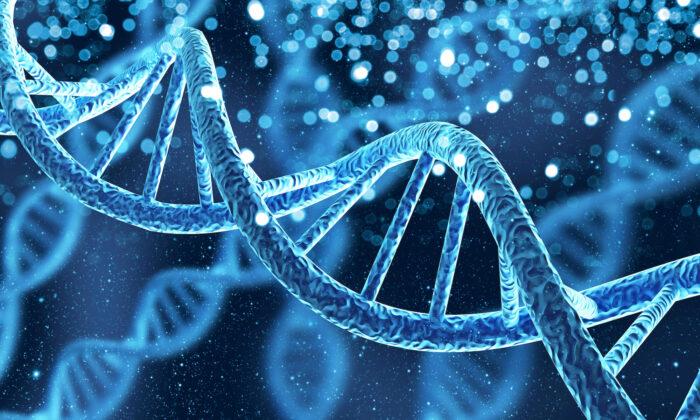Presidential candidate Robert F. Kennedy Jr. says that he thinks many of the causes of sexual dysphoria, particularly with boys, are coming from chemical exposure. In particular, he mentioned the widely used herbicide atrazine.
In the June 5 interview, Kennedy and Jordan B. Peterson and Kennedy discussed a wide range of topics including Kennedy’s presidential bid. When the conversation turned to environmental issues, Kennedy noted that the “huge levels of depression” seen in today’s kids, as well as “a lot of the sexual dysphoria that we’re seeing,” may be the result of toxic chemicals.
“These kids are swimming through a soup of toxic chemicals today, and many of those are endocrine disruptors,” Kennedy said.
Kennedy said that one of the big issues is atrazine, which he says can be found “throughout our water supply.” He went on to reference a study in which male frogs were exposed to atrazine in a tank, leading to their chemical castration and forced feminization.
Even more concerning, he noted that the study found 10 percent of the male frogs turned into “fully viable females, able to produce viable eggs.”
“If it’s doing that to frogs, there’s a lot of other evidence that it’s doing it to human beings as well,” Kennedy said.
The Science
The study that Kennedy referred to was led by Tyrone B. Hayes, professor of integrative biology at the University of California–Berkeley. It was published in March 2010 in the Proceedings of the National Academy of Sciences.The study noted that atrazine is one of the most commonly used herbicides in the world, as well as the most commonly detected herbicide contaminant. It taints ground, surface, and drinking water and can travel via rainfall more than 620 miles from its application site.
The authors stressed that the herbicide is a potent endocrine disruptor, even at low levels. Previous studies showed adverse effects that included hermaphroditism, reduced testicular volume, and lowered testosterone. The herbicide is also associated with both the demasculinization and feminization of male amphibians.
The study examined the long-term effects of atrazine on reproductive function in a genetically male population of African clawed frogs.
The male frogs were exposed to 2.5 parts per billion (ppb) of atrazine starting when they were tadpoles and continuing for up to three years after they metamorphosed into adults.
Functionally Female Frogs
Significantly, after exposure to atrazine, 10 percent of the genetic males developed into fully functional females with ovaries and viable eggs.Two of the male-turned-female frogs were mated with control males and produced offspring. Further testing confirmed that these atrazine-exposed male frogs, although now functionally female (having undergone complete feminization) were, in fact, still chromosomal males.
Big Pharma, Big Herbicides
In fact, aromatase is so important as a cause of breast cancer that one of the leading treatments for breast cancer is a nonsteroidal aromatase inhibitor called Letrozole, Hayes said.The study notes that “the results suggest a relationship between exposure to triazine herbicides and increased breast cancer risk, but conclusions concerning causality cannot be drawn, due to the limitations inherent in ecologic study design.”
Hayes emphasized that his study was not a singular study, but rather a comprehensive body of research.
In fact, 22 independent researchers from several different countries have examined the effects of atrazine exposure on various species including fish, reptiles, amphibians, mammals, and birds.
These studies consistently reported similar findings, including the absence of sperm production, demasculinization, and feminization as a result of atrazine exposure, he said.
Known Harms Reported by US Agencies
In 2003, seven years before the study by Hayes, a detailed toxicological profile of atrazine (pdf) was issued by the ATSDR, which is part of the Department of Health and Human Services.The report cited studies indicating that atrazine affects health in several ways: “One of the primary ways that atrazine can affect your health is by altering the way that the reproductive system works.
“Atrazine has been shown to cause changes in blood hormone levels in animals that affected the ability to reproduce. Some of the specific effects observed in animals are not likely to occur in humans because of biological differences between humans and these types of animals. However, atrazine may affect the reproductive system in humans by a different mechanism.
72 Million Pounds a Year
The report noted the widespread use of atrazine in the United States, although it is a restricted-use herbicide, meaning that it is not available to the general public.An Environmental Protection Agency (EPA) memorandum on the use of atrazine, published in July 2022, noted that the herbicide is registered for use in agricultural crops, including field corn, sweet corn, sorghum, sugarcane, macadamia nuts, and guava. It is also registered for non-agricultural uses, such as in nursery or ornamental plantings, turf, and rights-of-way (excluding roadsides). The memo noted that field corn, sweet corn, sorghum, and sugarcane are the most important agricultural use sites for the chemical.
The ATSDR report stated that atrazine has the potential to be carried through the air or be washed away from the soil by rain, ultimately finding its way into nearby streams, lakes, and other waterways. Moreover, it can penetrate deeper layers of soil and contaminate groundwater. Additionally, plants growing in these areas can absorb atrazine.
Once atrazine enters streams, waterways, or groundwater, it tends to persist for extended periods because of its slow breakdown in water.
EPA’s 2021 Biological Evaluation
In November 2021, the EPA issued the finalized version of its Biological Evaluation of the herbicides atrazine, glyphosate, and simazine, examining the potential risks to endangered and threatened species from these herbicides.The evaluation found that all three herbicides are “likely to adversely affect” species listed under the Endangered Species Act, or their designated habitats.
Additionally, atrazine will no longer be used “on roadsides, Conservation Reserve Program land, conifers, including Christmas tree plantings, timber and forestry areas, and miscanthus and other perennial bioenergy crops,” according to the EPA release.
A Syngenta representative, responding to questions from The Epoch Times, said that the herbicide was primarily used to control weeds in corn, sorghum, and sugar cane crops.
“Herbicides are crucial tools for helping farmers manage weeds and significantly increase crop yields while decreasing the amount of tillage, which prevents soil erosion and greenhouse gas emissions, and improves water and wildlife habitat,” the representative said.
“Atrazine has been extensively studied over the past 50 years. Nearly 7,000 studies have concluded it is safe for humans and the environment and it has been approved by international organizations and governments around the world.”





